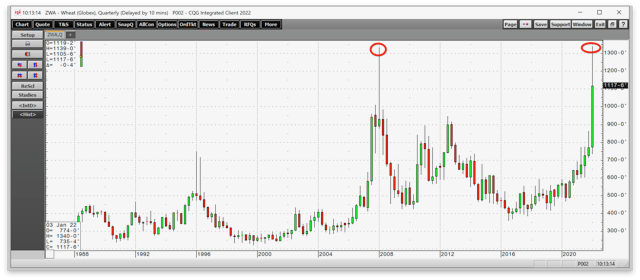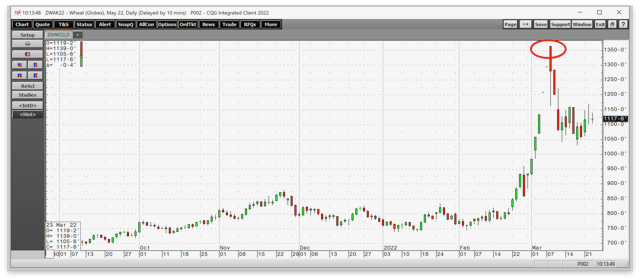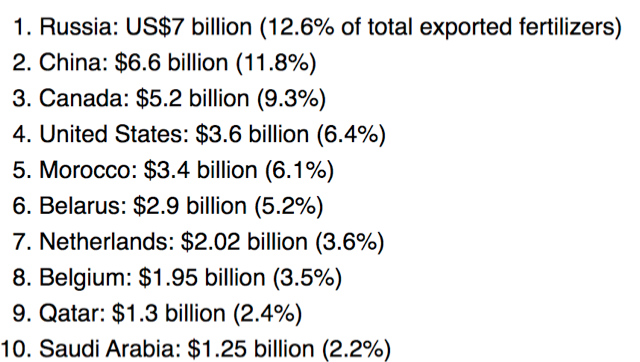This article was written exclusively for Investing.com
- The global benchmark wheat price hits new all-time high
- A taste of wheat’s political history
- Russia, Ukraine export a third of world’s wheat
- High prices and shortages could cause famine, revolution
- Weather in other growing regions never more important
In late March 2022, farmers in the northern hemisphere begin planting seeds that will grow into the crops that feed an ever-growing world population. Approximately 6 billion people inhabited our planet at the turn of this century. Now, the world’s population is more than 7.885 billion, an increase of over 31% in 22 years. Each quarter, it grows by around 20 million, meaning that the demand for food is constantly rising.
Wheat is the primary ingredient in bread, a nutritional staple. Wheat is more than a food ingredient; it is an essential commodity for governments, as feeding people is crucial for remaining in power and controlling the masses. In 2022, the price action in the wheat futures market reflects the war in Ukraine and a turbulent geopolitical landscape. The price of wheat is raising a warning sign that worldwide famine and revolutions could only exacerbate the problems caused by the war in Ukraine.
The Global Benchmark Wheat Price Hits New All-Time High
While various wheat contracts trade on futures exchanges in the U.S. and worldwide, the CBOT soft red winter wheat futures contract is a global benchmark for prices. In March 2020, the CBOT wheat futures price spiked higher to a new record peak.

Source: CQG
As the quarterly chart illustrates, CBOT wheat futures reached $13.40 per bushel in March, eclipsing the 2008 $13.3450 all-time high.

Source: CQG
The daily chart of the active month May CBOT wheat futures shows the price rose to $13.6350 per bushel before correcting to just above the $11.15 level on Mar. 23. CBOT wheat futures had not traded above $10 since 2008.
A Taste Of Wheat’s Political History
Wheat has a long history as a commodity with significant political ramifications when the price rises and availabilities become scarce. Wheat is the primary ingredient in bread, a nutritional essential.
The last queen of France, Marie Antoinette, was executed at the guillotine on Oct. 16, 1793. Her insensitivity to the plight of her subjects during a bread shortage was one of the reasons for her beheading. The subsequent revolution in France in 1848, the so-called Third French Revolution, began because of social and political discontent as workers lost their jobs, bread prices rose and people accused the government of corruption.
During the U.S. Civil War, in March and April 1863, bread riots were events of civil unrest in the Confederacy. There were flour, bread, and food riots in New York City in 1837 and 1917. Feeding people is a critical function of government, and when leaders fail, they often lose power.
The latest example comes from the Arab Spring that began as a series of bread riots in Tunisia and Egypt in 2010 after global wheat prices reached their last all-time high in 2008. Bread scarcity and high prices caused government change across North Africa and the Middle East. History could repeat in 2022 and the coming years as the world faces food shortages because of the war in Ukraine.
Russia, Ukraine Export A Third Of World’s Wheat
Russia and Ukraine are Europe’s breadbasket.

Source: beef2live.com
The chart shows that Russia and Ukraine accounted for 32.83% of the world’s annual wheat exports over the past years.
The war in Ukraine has turned fertile soil into battlefields just as the 2022 crop year is getting underway. Meanwhile, the Black Sea ports are significant logistical locations for wheat exports. The conflict will cause interruptions or stoppages, leading to wheat and other agricultural product scarcity from the region that also produces corn, barley, and other crops.
The war is not only impacting Russian and Ukrainian exports but worldwide production. Sanctions and retaliation led Russia to “temporarily” stop exporting fertilizers, just as the 2022 crop year begins in the Northern Hemisphere.

Source: Worldstopexports.com
Russia exports approximately 12.6% of the world’s fertilizers. The suspension will push prices higher and availabilities lower for all worldwide grain and oilseed production.
High Prices And Shortages Could Cause Famine, Revolution
The war in Ukraine has far-reaching worldwide consequences that could leave people in many countries hungry in 2022 and the coming years. The areas in the most danger are in Africa and the emerging markets, where poverty and famine are likely to spread and increase. China and India, the two most populous countries, could experience shortages along with the rest of the world. However, China and India have not sanctioned Russia, which will keep the supply chain operating.
In the U.S. and Europe, prices are likely to soar, feeding inflation that has already risen to the highest level in four decades before the beginning of the war in Ukraine.
Wheat and crude oil are the commodities at the heart of the war and Russia’s isolation from the western world. Russian President Vladimir Putin can use the grain, oil, and natural gas as pawns in the geopolitical chess game. Support from China only increases his powerful position as a leading supplier of commodities.
Weather In Other Growing Regions Never More Important
April showers bring May flowers. Across the fertile plains in the U.S., farmers will be planting corn, soybeans, wheat, and other crops over the coming weeks, with prices at or near all-time highs. However, farmers are paying more and more for land, financing, labor, fertilizers, farm equipment, energy, and all other inputs, making the high agricultural product prices a mirage. Inflation is causing the cost of production to soar.
Meanwhile, each year, the weather dictates if crops are sufficient to meet the ever-growing worldwide demand. A drought or flood in any of the world’s critical growing regions that causes crop production to decline over the coming months would be a disaster, given the situation in Europe.
A wheat shortage has a long history of triggering political upheaval. Russia can use global wheat supplies as a political and retaliatory tool. At more than $11 per bushel, with the potential to move higher, shortages are on the horizon, and civil unrest may follow over the coming years.
Which stock should you buy in your very next trade?
AI computing powers are changing the stock market. Investing.com's ProPicks AI includes 6 winning stock portfolios chosen by our advanced AI. In 2024 alone, ProPicks AI identified 2 stocks that surged over 150%, 4 additional stocks that leaped over 30%, and 3 more that climbed over 25%. Which stock will be the next to soar?
Unlock ProPicks AI